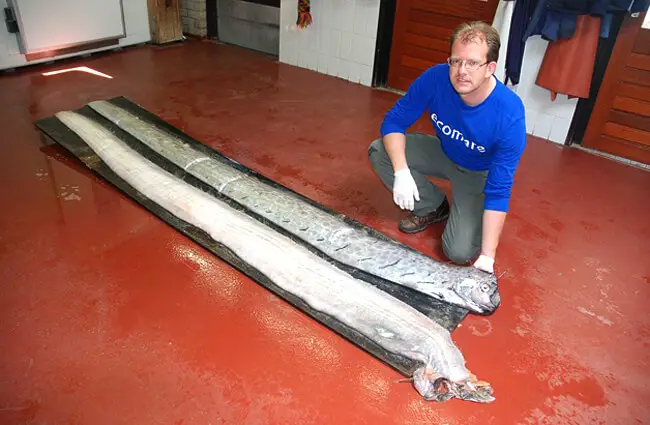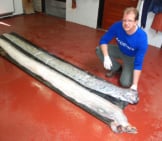The Oarfish is an extremely elongated fish that lives primarily in the open ocean. Researchers currently recognize three different species, the Giant Oarfish, the Streamer Fish, and Regalecus russelii, which has no common name. For our purposes, we will focus on the giant species, as it is the most well-known. Read on to learn about the Oarfish.
Description of the Oarfish
This species has an extremely elongated body, a crest on its head, a dorsal fin down the length of its back, and long, narrow pelvic fins. All of its fins have red coloration. Its body has iridescent silver coloration, and is scaleless.
Individuals of this species commonly measure 10 ft. long. However, the largest recorded specimen measured 36 ft. long, and some reports indicated they could reach up to 56 ft. long or more!
Interesting Facts About the Oarfish
These fish certainly reach impressive lengths. Learn what else makes this species impressive, below.
- Record-Holder – Not only does this fish reach immense lengths, but it’s actually the longest bony fish species in the world. Some cartilaginous species, like sharks, surpass its length.
- In the Family – Ironically, this species shares a taxonomic order with a fish of an entirely different shape. Researchers place both this species, and the moon fish in the same taxonomic order, Lampriformes. The moon fish as a large, nearly circular-shaped body.
- What’s in a Name? – People call these fish “oar”fish because originally they believed the fish rotated their long pelvic fins through the water similar to oars on a rowboat. Researchers now know that the fish use their dorsal fins to propel themselves.
- Colorful Fins – One of the primary sources of food for this fish is krill. The orange-colored krill that they eat likely cause the bright colorations of this species’ fins.
Habitat of the Oarfish
These fish inhabit pelagic waters, or the open ocean. This means that they do not live excessively close to the coast. They primarily inhabit deeper waters, or the mesopelagic and epipelagic zones.
Researchers believe that the shallowest waters they inhabit flow about 600 ft. below the surface. Their deepest habitats reach as far as 3,000 ft. below the surface or more.
Distribution of the Oarfish
Very few recordings of living individuals exist because these fish live so deep. People have found dead and dying individuals in oceans worldwide. However, the current might have pushed these fish outside their normal range.
This species in particular lives throughout the Northern and Southeast Atlantic Ocean. It also lives in the South Pacific Ocean.
Diet of the Oarfish
This fish species has carnivorous feeding habits. Despite their immense length, they feed primarily on small marine creatures. Krill make up a large portion of their diet, as well as other shrimp, plankton, squid, and small fish. Researchers know very little about their hunting behavior, as they have only observed a few live specimens.
Oarfish and Human Interaction
Humans often become captivated by this immense creature when it makes its way to the surface. Dead and dying individuals often float along the surface of the water or wash up on beaches. In some areas, people accidentally catch this fish in nets set for other species.
However, this interaction has not impacted the overall population health. The IUCN lists this species as Least Concern.
Domestication
Humans have not domesticated these fish in any way.
Does the Oarfish Make a Good Pet
No, you could not keep this species as a pet. It lives in the deep sea, and you cannot replicate the amount of pressure in the water in a home aquarium.
Oarfish Care
People do not keep this fish in aquariums. Besides their immense length, they live in incredibly deep waters, and their body cannot regulate to the lower pressure of surface waters. For this reason, researchers cannot replicate their natural habitat to keep them in human care.
Behavior of the Oarfish
Scientists know very little about these fish. Researchers did not record this species in its natural habitat until 2010. The species uses its elongated dorsal fin to swim through the water in search of prey. While swimming, they keep their bodies in a column-like orientation with their tails downward and their head upward.
Reproduction of the Oarfish
As is the case with behavior and hunting, scientists know very little about the exact breeding habits of these fish. A single female can produce hundreds of thousands, to millions of eggs. She lays her eggs in the water column, and they float freely in the water.
Beliefs, Superstitions, and Phobias About the Oarfish
Many scientists believe that this species caused folklore about sea serpents. People often misidentify beached specimens as sea serpents. This is likely due to their long, slender bodies, which resemble those of a lengthy snake.









![Red Angus Closeup of a beautiful Red Angus cowPhoto by: U.S. Department of Agriculture [pubic domain]https://creativecommons.org/licenses/by/2.0/](https://animals.net/wp-content/uploads/2020/03/Red-Angus-4-238x178.jpg)


![Red Angus Closeup of a beautiful Red Angus cowPhoto by: U.S. Department of Agriculture [pubic domain]https://creativecommons.org/licenses/by/2.0/](https://animals.net/wp-content/uploads/2020/03/Red-Angus-4-100x75.jpg)

